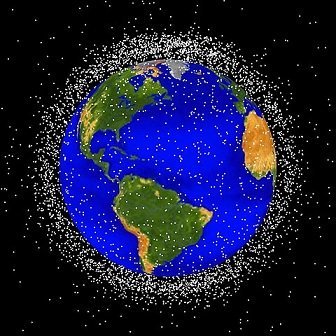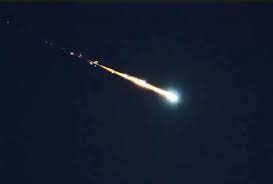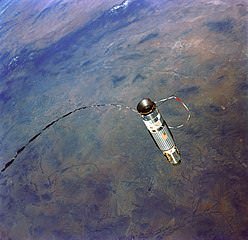Clearing Up Orbital Junks - Recycling; An Answer?
Introduction
Since man's first attempt to place an object in space - which was in the 1940s; when the first ever rocket was launched [ref]; placing of objects in space has been happening every now and then. But have you stopped to wonder; when these objects (satellite, rockets fuel backpack) fall out of orbit or get disbanded in space, where do they go? Obviously; you already know the answer - they orbit freely in space and form what is called "Orbital Debris". What are the pecks of having huge deposit of these in our orbit? Okay just hang on.

[Image Source: Wikimedia Commons. Author: NASA. Public Domain Licensed]
Threats of orbital debris
Before the advent of space exploration and all whatnot, the only broken fragments seen to float around our solar system were just from natural bodies; like broken pieces of asteroids, etc. But when man came on the scene, a whole lot of things changed and the number of junks in our solar system has been on the increase every now and then. Just some few months ago, we were celebrating Elon Musk's achievement of placing the Heavy Falcon into space, but have we considered the flip side of this. Maybe this would not make much meaning to you. Here in Nigeria, our own indigenous satellite - NigComSat-1, after launching; maybe by error or something; it got disbanded in the space too [ref] - Imagine what the space would become when tonnes of useless freely orbiting objects fill up the whole space.
I know some of you would already be saying that "the majority of these orbital junks are tiny in size, and would not pose any serious threat". Okay let's say you're right in your assumption that most of them are small-sized. But let's consider this fact: These junks are orbiting at terribly insane speed.
A whopping excess of half-a-million of these junks travel freely at an insane 17,500 miles per hour. - Paraphrased from NASA's report.
Let me use another point to buttress that size may not matter as much as speed. Have you ever seen the size of the bullet of a semi-automatic gun before? You would agree with me that it is not bigger than your pinky finger. If someone picks up the bullet and throws at you, you might probably not get hurt a bit, but when the same bullet is fired with speed from the barrel of a gun, then you would agree with me that it is not humorous. In the same way; at these insane speeds, what do you think would happen if one or more of these junks hit any of the useful space stations or even a space shuttle or a satellite? Definitely, it would spell c-a-t-a-s-t-r-o-p-h-e; not because of the size, but because of the speed. Maybe this video would give you a representation of what I mean.
[Video Source: ABC News]
So you see, these junks are already much up there, but these; if not checked on time; would not even be compared to the amount of junks that would be in our space in few years from now, because humans wouldn't stop sending stuffs to space - how human (and now they are even considering space colonization. That means; more stuffs would be sent there). Have you ever thought that a time could come when it would be almost practically impossible to go into the space? Because any space shuttle that does so would be hit massively by these nasty and annoying junks. So in view of this, what would be the feasible panacea to this? Just like it is said; "the solution of a problem may not be too far from the problem" - so why not turn these nasty enemies into friendly allies?
The panacea; Recycle! Recycle!!
Just like I mentioned earlier, majority of these junks are made of disbanded and broken pieces of objects that were earlier used in the fabrication of space stuffs (satellites, rockets, etc), and these materials cost fortune to produce. Some are even made from rare earth metals. Now considering the so much cost that is involved in the production of these metals; why not figure out ways to tap back these metals from these junks? Thereby re-using them, and clearing up the space (sounds like using a pebble to hit two birds).
But the mechanism upon which these recycling would be done has left humankind progressing in futility until very recently that ideas were raised in that regards. Firstly, you can't just walk into the space and start collecting these orbital junks with bare hands - it would sound like catching live bullets with bare hands. Even when these junks enter the earth's orbit, the speed would still be insane. That is the reason, when a meteorite hit the earth; for example; they do so with great impact, and some of them even enter with blazing heat; because of the frictional force being exacted on them by the air as they enter into our atmosphere. A renowned aerospace engineer; Stuart Grey affirmed this:
The speed by which space objects enter the lower orbit could be as high as 4.3miles per second. - [Stuart Grey]

[Image Source: Flickr. Author: Tonynetone. CC BY 2.0 Licensed]
So how do we catch these orbital debris? I know some would begin to think that if it were possible to design a specialized space shuttle that would have an almost equal speed with these junks (on average), then they would be used to catch them. But the truth is; it would not be too pocket-friendly to come up with that kind of space shuttle to withstand such an amount of speed. But hey! Other options abound. What of the ultra-light spacecraft from NASA's Innovative Advanced Concepts? They can get the job done [ref: from Vid], but how? This spacecraft would have some attachments of tough net-like structures; whose function is to grab the debris in-between and drag them along, thereby controlling both the speed and the direction of the junks. Just look at it the way the net of a football goal post can catch a ball at high speed; that’s just how this spacecraft works. But here, the ultimate goal of the spacecraft is to drag these debris back home, so they can be used to design other space equipments to be launched and still mess up the space, lol. (So the cycle continues - but it's still better than leaving the debris there, and launching more to meet them).
But even if that one seems not to fall within your preference, there's yet another one. But here, cables that are electrified would be sent to the space, which would have the ability to magnetize these junks and cause an alteration in their direction, and as soon as they enter our own atmosphere with that speed from the space, the air resistance would supply the needed friction to burn them up - that is called "Aerodynamic tethering".

[Image Source: Wikimedia Commons. Author: NASA. Public Domain Licensed]
So here, you would only succeed in clearing up the space, but you can't re-use the materials, because the aim here is to burn them up. So whichever one we choose to fall back on; the only important thing is that our space would; at least; be freer from these junks. And maybe, hoping that humans would not mess it up again, lol.
Conclusion
Man's space activity has been one of the achievements that has wowed mankind, but this is not without some obvious consequences - like the messing up of our space and orbit. Over the years, this has been a great concern, but salvation has finally arrived with the idea of recycling these stuffs; like we've seen. Well, maybe in the nearest future, there would be a complete debridement of the space - sounds cool, right?
Thanks for reading
References for further reading:
- Challenges of space debris
- Dealing with orbital debris – space.com
- Orbital debris – nasa.gov
- Destroying space debris - futurism
- Concept of orbital debris – nasa.gov
- Utilizing space junks – futurism
All images are CC Licensed and are linked to their sources


gif by @foundation
I guess the cost of getting the debris off space far outstrips the cost of manufacturing new material for the satellites.
But the truth is, if we don't get them off, they'll be accumulating. And very soon, our space would be like "Lasma" garbage dumping ground :)
Hey mentor
You really did a good job here. I have read a couple of articles on the menace of space junk in the past and the solutions being proposed and those already being undertaken to get rid of them. And it's not just one country that's involved in this effort.
It is quite saddening that after polluting the earth, we have gone beyond earth threshold to pollute outer space too. But we can't live without satellites we have got up there. So removing these junks is a must.
I really enjoy this and your writing style makes it more interesting.
Great
Thanks for the nice comment.
Well, humans would always leave their signature anywhere they go to, lol.
So maybe these orbital junks are our own signature, so that "space" would remember we came visiting 😂😂😂
Hahaha you made sense here man!
Aerodynamic tethering is the best option.
The speed with which this debris falls is too much.
I read a new long time ago of how a space junk would fall in China
Yeah; that's the reason the debris would get burnt up (all or part) when they are tethered to breach the earth's atmosphere.
This post has been voted on by the steemstem curation team and voting trail.
There is more to SteemSTEM than just writing posts, check here for some more tips on being a community member. You can also join our discord here to get to know the rest of the community!